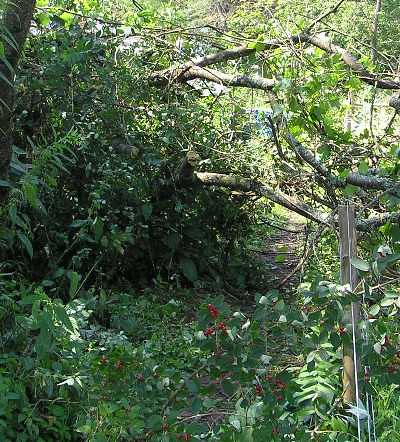Fencing

This morning I went out to milk and found these sumacs laying on the fence and blocking the path. It was the second time this weekend.

The fence was loaded pretty good, at least half way to the ground and very tight. It took a while to cut through with a bow saw and a pair of loppers. By the time I was done, the fence had regained it's line. Gotta love high tension fence and glad I put springs on it.
I have been dealing with fencing a lot lately.
Last year we enlarged our number of paddocks so we could have better rotation for parasite management. I moved the goats up to the backfield a couple of weeks ago. Now my push is to keep enough browse fenced in ahead of them. I am trying to move away from hay and more towards pasture only for the growing season.
This spring I fenced the new garden plot with the super deer fence. It is in the middle of th new goat pasture. Half of the garden is grown up with brush, poplar and small pines. Great browse for goats. So for the last month I have been browsing the goats inside the deer fence on the undeveloped half of the garden. But now that I am starting to use areas outside the deer fence, keeping ahead of the goats with new fence is challenging. I have a threefold goal of re-establishing old fence lines, keeping the goats fed and keeping the goats moving enough so I am not recycling pasture more than every four months. Someday, the goal is to have a lower perimeter fence forming a ring of goat pasture around the garden. But it won't happen all at once. For now, I am planting posts where I can and cutting through a lot of honeysuckle. After the goats have chewed their way through it will be easier to see the lay of the land and decide on the permanent fence line.
I also have two groups of goats to deal with. The Does and the Bucklings. Since I am keeping the Bucklings intact, it's important they are separate. Wouldn't want any hanky panky going on prematurely.
It took me a while, but I think I have finally worked out a cycle I think will work and am putting together the infrastructure to make it happen. I want the Does to see the pasture first and get the choicest bits. Then rest it for a week before I turn the Bucklings in to clean it up. That way I always keep a double fence between the Does and the Bucklings, no piece of ground sees animals for more than four weeks in four months, and I can keep a portable milking hut in the resting pasture. It beats moving the does back and forth from the backfield to the milking parlor at the back of the barn. The portable milking hut in the resting paddock between the Bucks and the Does was the key.
At present, I am just using three strands of poly wire to keep the goats in. Is nice because it is easy to work with, coils easily and doesn't require any tools. Also, a simple post in a reasonable hole for corner posts and fiber glass rods as line posts on long runs is all it requires to stay up. No need for corner bracing or getting elaborate. Sometimes I find the Bucklings need the extra convincing of a fourth wire, but that's not really a big deal. I hear a lot of horror stories about people unable to contain their goats. With our Saanens, I just don't see it. About the worst thing they do is play hard to get when it's time to put on a lead.
In the future, I would like to put up a 5 wire high tension fence around the entire goat fence. That way I could section for paddocks simply by stretching poly wire between the outer perimeter fence and the inner deer fence around the garden. I like the high tension smooth steel wire for permanent fencing. It is a significant physical barrier on it's own. But backed up with the fence charger, it is very convincing to those I want to keep in and those who should stay out. It isn't hard to string and I can take it down if I feel the need. If I turn of the charger, it isn't menacing to those who know it is off. And it takes a beating.










